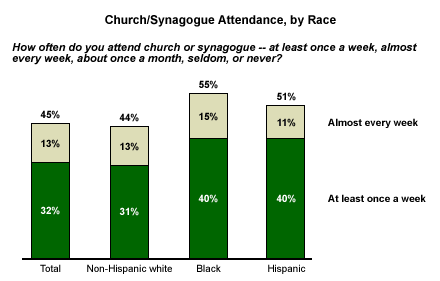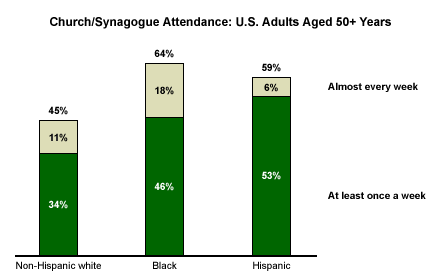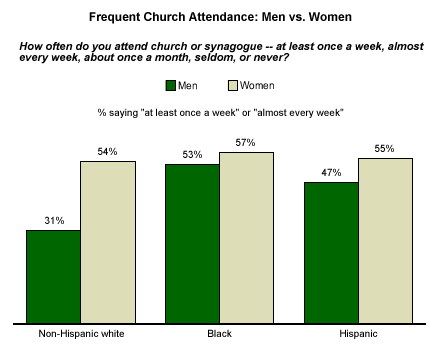On any given weekend, roughly 140 million Americans make their way to the hundreds of thousands of houses of worship that dot America's landscape. If a survey researcher could "open the doors and see all the people," who would be there? Proportionally more women of any race or ethnicity than anyone else, and proportionally fewer white men.
According to ║┌┴╧═Ї's annual Minority Rights and Relations survey*, black Americans and Hispanic Americans are more likely than white Americans to attend church/synagogue on a regular basis. Overall, 45% of Americans attend church or synagogue "at least once a week" or "almost every week." This percentage includes 44% of whites, 55% of blacks, and 51% of Hispanics.

The Age Difference
Age makes little difference among whites, but among blacks and Hispanics, attendance improves with age. Forty-four percent of whites between the ages of 18 and 49 attend services at least almost every week, and 45% of whites aged 50 and older attend that frequently. Among blacks and Hispanics, however, there is a notable increase by age: 49% of 18- to 49-year-old blacks attend at least once a week (36%) or almost every week (13%), compared with 64% among the 50+ age group (46% at least once a week, 18% almost every week). Among Hispanics, the percentage of those attending weekly or almost every week grows from 49% in the younger age category to 59% in the older age group with the percentage of those attending at least once a week rising from 36% to 53%.

The Gender Gap
Proportionally, more women than men regularly attend religious services; nationally, 35% of men and 54% of women attend at least almost every week. But a closer look at these numbers reveals some interesting findings: The attendance gap is essentially non-existent between black men and black women (53% vs. 57%) and very modest between Hispanic men and Hispanic women (47% vs. 55%). The real difference in church attendance is between white men and white women: Only 31% of white men say they attend at least almost every week, compared with 54% of white women -- a 23 percentage-point gap. Among white men and those of other races and ethnicities, there is a huge disparity: Only 31% of white men attend at least almost every week, compared with 53% of black men and 47% of Hispanic men.

Bottom Line
Significantly more black men and Hispanic men regularly attend religious services than white men do. That much is clear. But the reasons for the differences between church attendance of white men and that of black men and Hispanic men (and white women, for that matter) are not as clear. It could be that for blacks and Hispanics, religious congregations are still a center of social life and houses of worship play a much larger social role than for whites -- especially white males. White males may also perceive a lack of opportunities for developing their talents and strengths (see "Religion and Gender: A Congregation Divided, Part III," in Related Items), and perceive less social desirability in being known as a churchgoer.
The racial makeup of congregations and their leaders may play a significant role in helping religious leaders to lure white men to services (see "Race and Religious Leadership" in Related Items). Black religious leaders (91% of whom are male) seem to be more successful at attracting and engaging black men than are their white counterparts (93% of whom are male)**. Leaders of predominantly white congregations would be well served by studying the successes of black congregation leaders, perhaps discovering how to re-engage a dwindling yet important constituency.
*The results are based on telephone interviews with a national sample of 2,250 adults, aged 18 and older, conducted June 9-30, 2004. For results based on this sample, one can say with 95% confidence that the maximum margin of sampling error is ±5 percentage points. In addition to sampling error, question wording and practical difficulties in conducting surveys can introduce error or bias into the findings of public opinion polls.
For results based on the sample of 816 non-Hispanic whites, aged 18 and older, the maximum margin of sampling error is ±6 percentage points.
For results based on the sample of 801 blacks, the maximum margin of sampling error is ±8 percentage points.
For results based on the sample of 503 Hispanics, the maximum margin of sampling error is ±8 percentage points. (164 out of the 503 interviews with Hispanics were conducted in Spanish.)
**Results are based on telephone interviews with 1,000 adult members of a church, synagogue, or other religious faith community, aged 18 and older, and 500 nonmembers, conducted in October and November 2003. For results based on this sample, one can say with 95% confidence that the margin of sampling error is ±2.6 percentage points.
